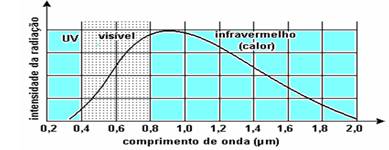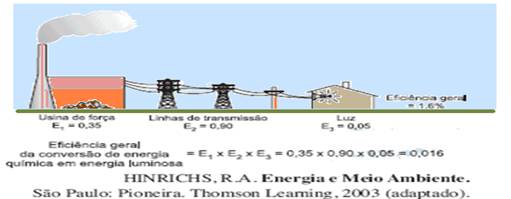Electric energy – EN Resolution
ELECTRIC ENERGY – RESOLUTION
Entrance exam exercises with commented solutions on
Electrical power – Electrical energy
01-(UNICAMP-SP) Consider the following equipment operating at maximum power during





one hour: a 100W light bulb, a Beetle engine , a truck engine, a 40W light bulb, an iron.
a) Which lamp consumes less energy?
b) Which equipment consumes the most energy?
c) Place the five devices in ascending order of energy consumption.
02-(ENEM-MEC) The average distribution, by type of equipment, of electricity consumption in homes in Brazil is shown in the graph.

In association with the graph data, consider the variables:
I. Equipment power.
II. Hours of operation.
III. Number of equipment.
The value of the percentage fractions of energy consumption depends on
![]()
03-(ENEM-MEC) Among the numerous recommendations given for saving electricity in a home, we highlight the following:
– Replace incandescent light bulbs with compact fluorescent ones.- Avoid using the electric shower with the switch in the “winter” or “hot” position.
– Accumulate a quantity of clothes to be ironed with an electric iron at once.
– Avoid using multiple sockets to connect several devices simultaneously.
– Use wires with diameters recommended for their intended purpose in the electrical installation.
The common feature of all these recommendations is the proposal to save energy by trying to reduce, on a daily basis,
a) the power of electrical appliances and devices.
b) the time of use of the devices and appliances.
c) the consumption of electrical energy converted into thermal energy.
d) the consumption of thermal energy converted into electrical energy.
e) the consumption of electrical energy through leakage currents.
04-(ENEM-MEC) “…Brazil has the potential to produce at least 15 thousand megawatts per hour of energy from alternative sources”.
In the southern states alone, the potential for generating energy through agricultural and forestry waste is 5,000 megawatts per hour.
To get an idea of what this represents, the Ita hydroelectric plant, one of the largest in the country, on the border between Rio Grande do Sul and Santa Catarina, generates 1,450 megawatts of energy per hour.”

This text, transcribed from a widely circulated newspaper, contains at least ONE CONCEPTUAL ERROR when presenting production values and energy generation potential. This error consists of
a) present very high values for the energy quantity.
b) use the megawatt unit to express power values.
c) use electric units for biomass.
d) using the incorrect unit megawatt per hour.
e) present numerical values incompatible with the units.
05-(UNICAMP-SP) A circuit breaker is an electrical protection switch that turns off the circuit when the current exceeds a certain value.

The 110V electrical network of a house is protected by a 15A circuit breaker. The following equipment is available: a 2,200W water heater , a 770W iron and 100W light bulbs.
a) Which of these devices can be connected to the electrical grid, one at a time, without turning off the circuit breaker?
b) If only 100W lamps are connected to the electrical network, what is the maximum number of these lamps that can be connected simultaneously without turning off the 15A circuit breaker?
06-(UFPE-PE) A special lamp has a current versus potential difference curve as shown in the figure.

What power will be dissipated, in watts, in the lamp when it is subjected to a potential difference of 10V? 2W
07-(PUCCAMP-SP) The electric eel, or poraquê, a freshwater fish from the Amazon region, can reach 2.5 m in length and 25 cm in diameter. Its voltage source – the electroplates – is located in its tail, which occupies about four fifths of its length.

Depending on the size and vitality of the animal, these electroplates can generate a voltage of 600V and a current of 2.0A, in pulses lasting about 3.0 thousandths of a second, a discharge sufficient to stun a person or kill small animals.
(Adapted from Alberto Gaspar. “Physics”. v.3. São Paulo: Ática, 2000, p. 135)
The electrical energy that the eel generates, in each pulse, in joules, is:
![]()
08-(UFU-MG) Two irons consume the same power. The first was designed to be used at a voltage of 110 V, while the second for a voltage of 220 V.


Under the designed conditions of use of the irons, it is correct to state that:
a) the energy consumption will be greater for the first iron, and the current that will flow through the first will be greater than the current that will flow through the second iron.
b) the energy consumption will be the same for both irons, and the current that will flow through the first will be greater than the current that will flow through the second iron.
c) the energy consumption will be greater for the second iron, and the electric currents that will run through each iron will be the same.
d) the energy consumption will be the same for both irons and the electric currents that will run through each iron will also be the same.
09-(UNIFESP-SP) According to a manufacturer, a fluorescent lamp whose nominal values


are 11W / 127V equivalent to an incandescent bulb with nominal values of 40W / 127V. This information means that
a) both dissipate the same power and produce the same luminosity.
b) both dissipate the same power, but the brightness of the fluorescent lamp is greater.
c) both dissipate the same power, but the brightness of the incandescent lamp is greater.
d) the incandescent lamp produces the same brightness as the fluorescent lamp, dissipating less power.
e) the fluorescent lamp produces the same brightness as the incandescent lamp, dissipating less power.
10-(UNESP-SP) A cell phone charger, which can be connected to the cigarette lighter outlet.

A car, sold on the streets of São Paulo, bears the following inscription:
SUPPLY VOLTAGE; 24W
POWER CONSUMPTION: 150V
This instruction was written by a manufacturer with good practical knowledge, but careless about the meaning and correct use of the SI (International System) units adopted in Brazil.
a) Rewrite the instruction, correctly using the SI units of measurement.
b) Calculate the intensity of the electric current used by the device.
11-(ENEM-MEC) We can estimate the electricity consumption of a house by considering the main sources of this consumption. Think about the situation in which only the appliances listed in the following table were used daily in the same way.

Table: The table provides the power and effective daily usage time of each household appliance.

Assuming that the month has 30 days and that the cost of 1kWh is R$ 0.40, the monthly electricity consumption of this house is approximately
a) R$ 135.
b) R$ 165.
c) R$ 190.
d) R$ 210.
e) R$ 230.
12-(UERJ-RJ) 4,000 60 W lamps and 600 120 W lamps are used to light the ship.

200 W, all subjected to an effective voltage of 120 V, which remain on, on average, 12 hours a day.
Considering this data, determine:
a) the total electric current required to keep them lit;
b) the approximate cost, in reais, of the energy they consumed on a 10-day trip, knowing that the cost of kWh is R$ 0.40.
13-(UNIFESP-SP) Currently, most electronic devices, even when turned off, remain in “standby”, an English word that in this case means “ready to use”. Keeping the equipment in this operating mode reduces the time needed for it to return to operation and prevents wear and tear on the internal circuits due to voltage spikes that appear the moment it is turned on. In other words, a device in this condition is always partially on and, therefore, consumes energy. Suppose that a television kept in “standby” dissipates a power of 12

watts and that the cost of a kilowatt-hour is R$0.50. If it is kept on “standby” for a year (assume 1 year = 8,800 hours), its energy consumption will be approximately
a) R$ 1.00.
b) R$ 10.00.
c) R$ 25.00.
d) R$50.00.
e) R$ 200.00.
14-(UERJ-RJ) A group of students, when observing a storm, imagined what the value would be, in reais, of the electrical energy contained in the lightning.

To define this value, the following data were considered:
– average electric potential of lightning = 2.5 × 10 7 V;
– intensity of the established electric current = 2.0 × 10 5 A;
– cost of 1 kWh = R$ 0.38.
– 1kWh = 3.6.106J
Assuming that lightning lasts for one thousandth of a second, the approximate value in reais, calculated by the group for the energy contained in it, is equivalent to:
![]()
15- (FUVEST-SP) The graph shows the variation of the effective current, in amperes, of an electric heater that operated under an effective voltage of 120V, for 400 minutes.


a) If the cost of electricity is C$0.20 per kilowatt-hour, determine the cost of the energy supplied to the heater during the indicated 400 minutes.
b) If 1/3 of the total energy transferred to the heater, in the first 42 minutes of operation, was used to heat 10 liters of water , determine the variation in water temperature. Consider: specific heat of water c = 4.2.103 kg /J and that the volume of 1L of water has a mass of 1kg and 1kWh = 3.6.106 J.
16-(UFRS-RS) To light their tent, a group of campers connect a lamp to a car battery.

The lamp consumes 6 W of power when operating at a voltage of 12 V. The battery has the following specifications: 12 V, 45 Ah, with the last value being the maximum charge that the battery can store. Assuming that the battery is ideal and that it is at half its maximum charge, and assuming that the current supplied by it remains constant until the charge is completely depleted, how many hours can the lamp remain in continuous operation?
![]()
17-(UFMS-MS) Solar energy is one of the alternative energy sources used by man. The average annual intensity of solar radiation in the city of Campo Grande – MS is equal to 700 W/m2 considering 6 hours of irradiation per day.


A solar energy capture device to heat water for domestic consumption has a yield equal to 60%, that is, 60% of the available solar radiation power is transformed into useful power by the device. Consider a residence that has one of these devices installed, whose solar radiation capture area is 4 m2 and all useful power is consumed. If the cost of electricity in the location is R$0.60 per kWh, the average annual savings (365 days) in reais, in this residence, will be
a) greater than R$2,124.00.
b) equal to R$551.88.
c) equal to R$ 367.92.
d) less than R$367.92.
e) equal to R$ 1,980.00.
18-(UNIFESP-SP) A consumer exchanges his 29-inch, 70 W television for a 42-inch, 220 W plasma television.

If you watch television for an average of 6 hours a day at home, it can be said that the increase in monthly electricity consumption that this change will entail is approximately
![]()
19-(FUVEST-SP) In most homes that have cable TV systems, the device that decodes the signal remains on without interruption, operating with a power of approximately 6 W, even when the TV is not on.

The energy consumption of the decoder, during one month (30 days), would be equivalent to that of a 60 W light bulb that remained on, without interruption, for
![]()
20-(UFG-GO) In Ecuador, the average solar radiation, per month, on the Earth’s surface, is approximately 792 MJ/m2 . For approximately how many hours must a heater with a voltage equal to 220 V and an electric current of 20 A remain on to produce an amount of heat equivalent to the monthly solar energy incident on 1.00 m2 ?
a) 3 hours
b) 20 hours
c) 50 hours
d) 250 hours
e) 1000 hours
21-(UFG-GO) A cell phone operates in a frequency range of 824 Hz to 849 MHz. The charges and battery life of 6V batteries for this type of phone are given in the following table.

a) Knowing that the speed of an electromagnetic wave in air is approximately 3.10 8 m/s, what is the approximate wavelength for the frequency of 830 MHz?
b) How much charge (in coulombs) is supplied by the 0.80Ah battery?
c) Calculate the electric current and average power supplied by the 0.80Ah battery.
22-(FUVEST-SP) Fluorescent lamps provide much more light than incandescent lamps of the same power. In compact fluorescent lamps (socket lamps), the luminous efficiency, measured in lumens per watt (lm/W), is around 60 lm/W, and in incandescent lamps, it is around 15 lm/W. In a residence, 10 100 W incandescent lamps are replaced by compact fluorescent lamps that provide equivalent lighting (the same amount of lumens). Assuming that the lamps are on for an average of 6 hours per day and that the price of electricity is R$0.30 per kWh, the monthly savings on the electricity bill for this residence will be approximately:
![]()
23-(PUC-SP) An immersion heater (boiler) dissipates 200W of power, fully utilized

to heat 100g of water for 1 minute. What is the temperature variation experienced by the water?
Consider: 1cal=4J and water =1cal/g o C
![]()
24-(FUVEST-SP) In most homes that have cable TV systems, the device that decodes the signal remains on without interruption, operating with a power of approximately 6 W, even when the TV is not on.

The energy consumption of the decoder, during one month (30 days), would be equivalent to that of a 60 W light bulb that remained on, without interruption, for
![]()
25-(ITA-SP) In 1998, the Itaipu hydroelectric plant supplied approximately 87,600 GWh of electrical energy.

Imagine then a giant photovoltaic panel that can convert into electrical energy, with a yield of 20%, the solar energy incident on the Earth’s surface, here considered with an average diurnal value (24 h) of approximately 170 W/ m2 .
Calculate:
a) The horizontal area (in km2 ) occupied by the solar collectors so that the panel can generate, over a year, energy equivalent to that of Itaipu, and,
b) The average percentage at which the plant operated in 1998 in relation to its installed capacity of 14,000 MW.
26-(FUVEST) Fluorescent lamps provide much more light than incandescent lamps of the same power. In compact fluorescent lamps (socket), the luminous efficiency, measured in lumens per watt (lm/W), is around 60 lm/W, and in incandescent lamps, it is around 15 lm/W. In a residence, 10 100 W incandescent lamps are replaced by compact fluorescent lamps that provide equivalent lighting (the same amount of lumens). Assuming that the lamps are on for an average of 6 hours per day and that the price of electricity is R$0.30 per kWh, the monthly savings on the electricity bill for this residence will be approximately:
![]()
27-(UEL-PR) Some modern cars use high compression engines , which require a lot of power, which only an electric motor can develop.

Typically, a 12-volt battery is used to power the starter motor.
Assuming that this motor draws a current of 400 amps, the power required to start the motor is:
a) 4.0 × 10 2 W.
b) 4.0 × 10 3 W.
c) 4.8 × 10 3 W.
d) 5.76 × 10 4 W.
e) 1.92 ×10¦ W.
28-(ENEM-MEC) The passage of an adequate amount of electric current through the filament of a light bulb makes it incandescent, producing light. The following graph shows how the intensity of the light emitted by the bulb is distributed across the electromagnetic spectrum, extending from the ultraviolet (UV) region to the infrared region.

The luminous efficiency of a lamp can be defined as the ratio between the amount of energy emitted in the form of visible light and the total amount of energy used for its operation. Assuming that these two quantities can be estimated, respectively, by the area below the part of the curve corresponding to the visible light band and by the area below the entire curve, the luminous efficiency of this lamp would be approximately
![]()
29-(ENEM-MEC) The electrical installation of a house involves several stages, from the allocation of electrical devices, instruments and appliances, to the choice of materials that compose it, including the dimensioning of the required power, the necessary wiring, the conduits*, among others.
Each electrical appliance has an associated power value. Typical power values for some appliances are shown in the following table.

*Conduits are conduits through which the wiring of an electrical installation passes, with the purpose of protecting it.
The choice of bulbs is essential to obtain good lighting. The power of the bulb should be in accordance with the size of the illuminated room. The following table shows the relationship between the areas of the rooms (in m2 ) and the power of the bulbs (in W), and was used as a reference for the first floor of a residence.

Note: For the purposes of calculating areas, walls are disregarded.
Considering the floor plan provided, with all appliances in operation, the total power, in watts, will be:
![]()
30-(PASUSP) A domestic refrigerator has a power of 180W. In a 24-hour period, the compressor works for about 10 hours, thus maintaining the appropriate temperature inside the appliance. Knowing that the operation of this refrigerator represents, on average, 25% of the total energy consumption, the monthly consumption, in kWh, of this residence can be estimated as:
a) 54 b) 96 c) 128 d) 180 e) 216
31-(ENEM-MEC) The efficiency of an energy conversion process is defined as the ratio between the production of useful energy or work and the total energy in the process. The figure shows a process in several stages. In this case, the overall efficiency will be equal to the product of the efficiencies of the individual stages. The energy input that is not transformed into useful work is lost in unusable forms (such as waste heat).

Increasing the efficiency of energy conversion processes involves saving resources and fuel. Which of the following proposals will result in the greatest increase in overall process efficiency?
a) Increase the amount of fuel for burning in the power plant.
b) Use incandescent lamps, which generate little heat and a lot of light.
c) Keep the number of electrical appliances in homes to a minimum.
d) Use cables with a smaller diameter in transmission lines in order to save conductive material.
e) Use materials with better conductive properties in transmission lines and fluorescent lamps in homes.
32-(UNESP-SP) The battery shown, with negligible resistance, was constructed using, as electrodes, a copper sheet immersed in an aqueous solution containing Cu +2 ions (1mol.L -1 ) and a zinc sheet immersed in an aqueous solution containing Zn +2 ions (1mol.L -1 ). In addition to the battery, whose potential difference is equal to 1.1 volts, the circuit consists of a small lamp and a switch Ch. With the switch closed, the copper electrode had an increase in mass of 63.5μg after 193s.
![]()

Considering that the electric current remained constant during this time interval, the power dissipated by the lamp during this period was:
![]()
33-(UECE-CE)



A 12 V battery with a 60 Ah charge capacity powers a sound system, providing it with

system with a power of 60 W. Consider that the battery, at the beginning, is fully charged and will only power the sound system, so the battery voltage will remain at 12 V until the 60 Ah of charge is consumed. The maximum time of uninterrupted operation of the sound system in hours is:
![]()
34-(PUC-MG)




When reading the nameplate of an electric shower, the following values are found: 127 V –

4800W. It is CORRECT to state:
a) This equipment consumes 4800J of energy every second of operation.
b) The correct electrical current for this shower to operate is a maximum of 127 V.
c) The voltage suitable for its operation cannot be higher than 4800 W.
d) It is not possible to determine the correct value of the electric current with the available information.
35-(UNESP-SP) A physics student built an electric heater using a resistor. When connected to a 110 V outlet, the heater was able to make 1 liter of water , initially at a temperature of 20 °C, reach its boiling point in 1 minute. Consider that 80% of the electrical energy was dissipated in the form of heat by the heater’s equivalent resistor, that the specific heat of water is 1 cal/(g ´ °C), that the density of water is 1 g/cm3 and that 1 calorie is equal to 4 joules. Determine the value of the electrical resistance, in ohms, of the resistor used.
36-(UFJF-MG)




The graph shows the electrical power, in kW, consumed in the residence of a resident of the city of Juiz de Fora,
throughout the day. The residence is supplied with a voltage of 120 V. This residence has a

circuit breaker that trips if the electrical current exceeds a certain value, to prevent damage to the electrical installation. On the other hand, this circuit breaker is sized to support a current used in the operation of all appliances in the residence, which add up to a total power of 7.20 kW.

a) What is the maximum current value that the circuit breaker can withstand?
b) What is the energy in kWh consumed throughout a day in this residence?
c) What is the price to pay for a month of consumption, if 1kWh costs R$ 0.50?
37-(UFLA-MG)



The following figure represents the relationship between the electric potential difference volt (V) and the current intensity ampere (A) in an ohmic resistor. It is CORRECT to state that for a voltage of 150 V the resistor will dissipate a power of

a) 960 W.
b) 1500 W.
c) 1200 W.
d) 9600 W.
38-(PUC-RJ)




Three-temperature electric showers are widely used in Brazil. To install a shower, it is necessary to choose the power of the shower and the voltage that we will use in our electrical installation. In this way, if we install

a 4,500 W shower using a voltage of 220 V, we can use a circuit breaker that can handle the passage of 21 A. If we want to connect another 4,500 W shower to a 110 V voltage network, which circuit breaker should we choose?
![]()
39-(UERJ-RJ)




The table below shows the number of electrical devices in a home, the power consumed by each of them and the actual time of daily use in summer.

Consider the following values:
• absolute density of water: 1.0 g/cm 3
• specific heat of water: 1.0 cal.g -1 o C -1
• 1 cal = 4.2 J
• cost of 1 kWh = R$ 0.50
During 30 days of summer, the total expenditure on these devices, in reais, is approximately:
a) 234
b) 513
c) 666
d) 1026
40- (UERJ-RJ) The table below shows the number of electrical devices in a house, the power consumed by each of them and the actual time of daily use in the summer.

Consider the following values:
• absolute density of water: 1.0 g/cm 3
• specific heat of water: 1.0 cal.g -1 o C -1
• 1 cal = 4.2 J
• cost of 1 kWh = R$ 0.50
In winter, an electric heater is used every day to raise the temperature of 120 liters of water by 30 ºC.
During 30 days of winter, the total cost of this device, in reais, is approximately:
![]()
41- (UNIRG-TO)


The figure below shows a stun gun used for self-defense.

This device, when in operation, delivers a current of 2 mA (microamps) at a voltage of 50,000 volts, which is enough to incapacitate a person without causing permanent damage. The electrical power released during a shock with these characteristics, in watts, is
![]()
42-(UFT-TO)



A person takes 45 minutes to take a daily shower. It is known that his shower consumes 5000 Watts and a voltage of 220 Volts, and that the cost of energy is R$ 0.20 per [kW h]. How much does this person spend monthly on his showers?
Consider that the person takes a shower a day, and that the month has 30 days.
a) R$10.00
b) R$12.50
c) R$22.50
d) R$75.00
e) R$75.50
43-(PUCS-RS)



An electrical device initially has an internal energy of 550 J. It then receives from an electric current an amount of energy per time equivalent to 50 W, and begins to release in the form of electromagnetic radiation an amount of energy per time equivalent to 20 W. When the electrical device reaches an internal energy of 1000 J, it melts. How long will it take for this to happen? (Neglect any other loss or gain of energy outside the processes mentioned above.)
![]()
44-(UESPI-PI)

A student pays R$40.00 (forty reais) per month to use a 5000 W electric shower.

Knowing that this amount results from a fixed cost charge per kWh of electricity consumed monthly, he decides to save money by replacing this shower with another 4000 W one. If the new shower is used for the same amount of time as the old shower, the savings in one month will be:
a) R$ 5.00
b) R$ 8.00
c) R$ 15.00
d) R$ 20.00
e) R$ 39.00
45-(ENEM-MEC) The electrical energy consumed in homes is measured in kilowatt-hours by means of a consumption meter. On this meter, from right to left, there are the unit, tens, hundreds and thousands pointers. If a pointer is between two numbers, the last number passed by the pointer is considered. Suppose that the measurements indicated in the following diagrams were made in a city where the price of a kilowatt-hour was R$ 0.20.

The amount to be paid for the registered electricity consumption would be
a) R$ 41.80.
b) R$ 42.00.
c) R$ 43.00.
d) R$ 43.80.
e) R$ 44.00.
46-(UNIFOR-CE)




Our energy matrix is predominantly of hydraulic origin. Our plants, such as Itaipú, Sobradinho, Paulo Afonso and Tucuruí, are located at great distances from the centers

energy consumers, making it necessary to transmit energy through extensive lines. The choice for this type of transmission, in high voltage and low intensity alternating current, occurs because:
I. The transmission of large power at low voltage and low current is economically viable.
II. High-intensity, low-voltage current transmission would require a large loss of power due to the heating of the transmission lines.
III. Alternating current transmission allows for simplified voltage reduction through transformers at step-down stations in consumer centers.
a) I, only.
b) II, only.
c) III, only.
d) I and III, only.
e) II and III, only.
47- (UERJ-RJ) To start a truck, its 12 V battery must establish

a current of 100 A for one minute. The energy, in joules, supplied by the battery corresponds to:
![]()
48-(ENEM-MEC) Observe the following table. It contains technical specifications contained in the instruction manual provided by

by the manufacturer of an electric tap. Considering that the highest power model of the 220 V version of the Supreme tap was inadvertently connected to a network with a nominal voltage of 127 V, and that the appliance is configured to work at its
maximum power. What is the approximate power value when turning on the tap?
a) 1,830 W
b) 2,800 W
c) 3,200 W
d) 4,030 W
e) 5,500 W
49-(UFPA-PA)

A solar panel with an area of 1 m2 produces about 0.5 kW.h per day. With this in mind, a consumer interested in this energy source decided to evaluate his daily consumption needs, which are listed in the table below.

From this data, the minimum number of solar panels that this consumer needs to purchase to meet their needs
of daily energy consumption is
![]()
50-(ENEM-MEC)

First generation biofuels are derived from soybeans, corn and sugar cane and are produced through

fermentation. Biofuels derived from cellulosic material or second-generation biofuels – colloquially called “grass gasoline” – are those produced from wood waste (sawdust, for example), corn stalks, wheat straw or fast-growing grass and are an alternative to the problems faced by first-generation fuels, since the raw materials are cheap and abundant.
DALE, BE; HUBER, GW Gasoline from grass and other plants. Scientific American Brazil. Aug. 2009. n.° 87
(adapted).
The text shows one of the points of view regarding the use of biofuels today, which:
a) they are energy matrices with a lower pollution load for the environment and can provide the generation of new jobs, however, to be offered at a low cost, the technology for degrading cellulose in second-generation biofuels must be extremely efficient.
b) they offer multiple difficulties, as production is expensive, their implementation does not generate jobs, and care must be taken with environmental risks, as they offer the same risks as the use of fossil fuels.
c) being second generation, they are produced using a technology that causes social problems, mainly due to the fact that the raw material is abundant and easily found, which prevents the generation of new jobs.
d) being first and second generation, they are produced by technologies that must undergo a careful evaluation regarding their use, as one faces the problem of lack of space for planting the raw material and the other prevents the generation of new sources of employment.
e) can lead to serious economic and social problems, as replacing the use of oil negatively affects the entire production chain as it excludes several sources of employment in refineries, gas stations and in the transportation of oil and gasoline.
